Performance of Tree Species on Waterlogged Sites of Canal Command Area: A Case Study of Bargi Dam, Jabalpur (Madhya Pradesh)
Corresponding author Email: jainavi@yahoo.com
DOI: http://dx.doi.org/10.12944/CWE.16.3.12
Copy the following to cite this article:
Jain A, Gupta D, Banerjee S, Naik R. Performance of Tree Species on Waterlogged Sites of Canal Command Area: A Case Study of Bargi Dam, Jabalpur (Madhya Pradesh). Curr World Environ 2021;16(3). DOI:http://dx.doi.org/10.12944/CWE.16.3.12
Copy the following to cite this URL:
Jain A, Gupta D, Banerjee S, Naik R. Performance of Tree Species on Waterlogged Sites of Canal Command Area: A Case Study of Bargi Dam, Jabalpur (Madhya Pradesh). Curr World Environ 2021;16(3). Available From: https://bit.ly/2Ys2P5a
Download article (pdf)
Citation Manager
Publish History
Select type of program for download
| Endnote EndNote format (Mac & Win) | |
| Reference Manager Ris format (Win only) | |
| Procite Ris format (Win only) | |
| Medlars Format | |
| RefWorks Format RefWorks format (Mac & Win) | |
| BibTex Format BibTex format (Mac & Win) |
Article Publishing History
| Received: | 11-07-2020 |
|---|---|
| Accepted: | 03-11-2021 |
| Reviewed by: | 
 Dr. M.C. Manjunatha
Dr. M.C. Manjunatha
|
| Second Review by: |

 Dr. Vyas Pandey
Dr. Vyas Pandey
|
| Final Approval by: | Dr.S. K. Dash |
Introduction
The agricultural sector in India contributes 17% of the Gross Domestic Product (GDP) engaging 54.6% of the population of the country. Out of the total 328.7 million hectares geographical area of the country, the net sown area is 140.10 million hectares while 198.40 million hectares is the gross cropped area with 142% cropping intensity. However, the irrigated area is 68.4 million hectares as per the land use statistics 2013-141. Northern rivers owing to perennial in nature have enhanced water storage in the dams and provided irrigation facilities as an important means of promising water supply through the network of canals in northern plains for the states of Punjab, Haryana, Uttar Pradesh, Rajasthan, and Bihar. In spite of the much higher initial cost, canal irrigation has the advantage of enhancing soil fertility by bringing down a huge amount of sediments from the rivers2. When the root zone of the plant gets flooded with water and subsequent adverse effect on crop productivity, the land is called to be waterlogged3, which is one of the drawbacks of canal irrigation. This makes the high-water table in the agricultural land and affects more than 33 % of the World’s irrigated land along with salinity4. However, in India itself, the extent of the waterlogged area is 5.5-million-hectare in irrigated land out of total 8.4 million hectares affected area of soil alkalinity and salinity5,6.
Biodrainage is defined as vertical drainage of waterlogged soils in irrigated canal commands by strategically planting tree vegetation which is increasingly catching the fancy of a techno-scientific community of agricultural soil water management.7,8,9,10,11. The consumptive use of water by trees and consequent lowering of the water table of waterlogged soils through bio drainage is an established concept. There is a paucity of information on the comparative bio drainage potential of different tree species and on their morpho-physiological traits. A recent perusal of literature evidence that the majority of farmers have raised bio drainage plantations using Eucalyptus trees only. The present study aims to evaluate the performance of seven tree species planted on the bank of the Left Bank Canal of the command area of Bargi dam in Somti, Jamuniya and Dabhola villages in Jabalpur district of M.P.
Materials and Methods
Selection of Sites
The study sites were selected along the left canal of Bargi dam for experimentation and plantation of forest tree species. Waterlogged sites were selected in three villages namely, Jamuniya (23°03'32.5"N; 79°41' 59.3"E), Somti (23°03'09.3"N; 79°41'40.1"E) and Dabhola (23°04'54.2"N; 79°45'42.0"E) with the total area of 10 ha (Fig. 1).
Collection and Analysis of Soil Samples
Three soil profiles were excavated and different soil horizons were studied in detail about 30 m away from the canal near Somati, Jamuniya and Dabhola villages. The soil samples from different soil horizons of each profile were collected, processed and subjected to physico-chemical analysis for the quantification of pH, electrical conductivity, salt concentration, CEC, organic carbon, available nutrients, exchangeable cations, mechanical analysis including percent content of sand, silt and clay and texture12,13,14,15.
Raising Plantation of Tree Species
Seeds from phenotypically superior trees of Albizia lebbek, Albizia procera, Acacia nilotica, Dalbergia sissoo, Eucalyptus tereticornis, Terminalia arjunaand Pongamia pinnatawere collected, while seeds of FRI-4 and FRI-5 clones of Eucalyptus were procured from Forest Research Institute, Dehradun (Uttarakhand). The seedlings of these species were raised in Tropical Forest Research Institute, Jabalpur nursery and maintained for about one year in polybags through regular watering, weeding, cleaning and shifting.
A plantation of the selected seven tree species covering 10 ha area was raised at Somti, Jamuniya and Dabhola villages along LBC and biofenced by Agave Americana. Albizia lebbek, Albizia procera, Dalbergia sissoo, Jatropha curcas, Eucalyptus tereticornis, FRI-4 and FRI-5 clones of Eucalyptus hybrid and Terminaria arjuna were planted at low lying areas of Somti with shallow soil, which remains waterlogged most of the times when the canal runs. The plantations of Acacia nilotica and Pongamia pinnata were raised near Jamuniya village on the land with very shallow soil because the actual soil was used to construct the canal and unfertile land filled with boulders was left along the canal. Eucalyptus tereticornis and Terminaria arjuna seedlings were planted at Dabhola on the farmer’s field which was again a low-lying area. The spacing between the seedlings of all the planted tree species was maintained at 2m?2m, while Eucalyptus tereticornis seedlings were planted at both 2m?2m and 1m?1mspacings.
Measuring Growth and Biomass of Saplings
Growth characteristics of seedlings viz. height and girth were recorded using measuring tape on quarterly basis for 4 years or 16 quarters starting from September (post-monsoon) of first year to June (Pre-monsoon) of fifth year. Biomass studies of the seedlings were conducted after 4 years by destructive method16. After completion of the experiment, seedlings were uprooted, washed, plant parts like stem, branches, leaves and roots were separated, dried in oven and weighed.
Statistical Analysis
The growth and biomass data were statistically analysed using SPSS software (version 16.0). Analysis of variance (ANOVA) was calculated and critical difference at 1% and 5% significant level was estimated. Standard error mean was also calculated.
 |
Figure 1: Location Map of Study Sites along Left Bank Canal of Bargi Command Area. Click here to view Figure |
Results and Discussion
The data on growth and dry biomass of four years old plants of the selected seven tree species planted at Somti, Jamuniya and Dabhola are given in Table 1, while percent increase in growth characteristics has been depicted in Fig. 2. Average height of Eucalyptus hybrid seedlings increased 3.31 times from 1.05m to 4.53m and basal girth increased 10.35 times from 1.98cm to 22.48cm during the study period of sixteen quarters. During last two decades, Eucalyptus has been planted on large scale in the country because this species is fast-growing and becomes the part of ‘social forestry’ programmes providing fuel and timber to the rural communities17. Eucalyptus plantations have always been debatable between environmentalists and foresters, wherein the later support it due to not able to meet the ever increasing demand of local communities and industries for wood from the natural forests, while environmentalists oppose its plantations due to its alleged ecological consequences on soil and ground water18. Along the canal, Eucalyptus planted with both spacing grew together initially but after about 2 years, growth of Eucalyptus in 1m ?1m spacing were restricted to some extent because of competition for nutrients and overlapping of canopy16. The seedlings raised with the seeds collected from Eucalyptus tereticornis showed poor performance in comparison to seedlings raised from the seeds of FRI-4 and FRI-5 clones, which could be due to their genetic superiority over other one. Infestation of invasive insect, Leptocybe invasa severely deformed the Eucalyptus tereticornis seedlings and attacked leaves, petioles and stem. Few severely infested seedlings were removed to control spread of this insect to non-infested seedlings. The seedlings raised from FRI-4 and FRI-5 clones were rarely attacked and were found resistant for this insect.
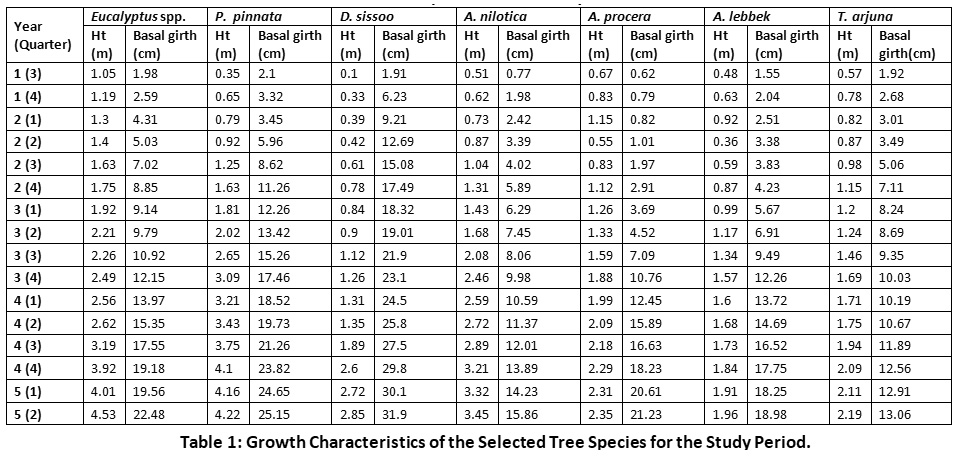 |
Table 1: Growth Characteristics of the Selected Tree Species for the Study Period. Click here to view Table |
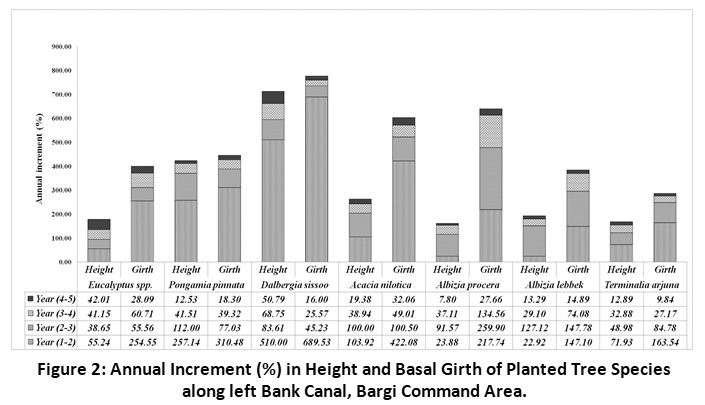 |
Figure 2: Annual Increment (%) in Height and Basal Girth of Planted Tree Species along left Bank Canal, Bargi Command Area. Click here to view Figure |
Initially the growth of P. pinnata and A.nilotica seedlings was slow, but after establishment of roots in the soil, the growth increased rapidly. At the time of planting, the average height and basal girth of P. pinnata seedlings was 0.35m and 2.10cm, which increased to 4.22m and 25.15cm, respectively at the end of experiment i.e., after 4 years. Similarly, height and basal girth of A. nilotica seedlings increased from 0.51m and 0.77cm to 3.45m and 15.86cm, respectively during this period. D. sissoo is a nitrogen fixing and highly preferred fodder tree species19but growth was found slower than E. hybrid and P. pinnata, which attained the average height and basal girth of 2.85m and 31.90cm respectively after 4 years of experimentation.
A. procera and A. lebbek belonging to family fabaceae are fast growing nitrogen fixing tree species. A. procera, is the preferred tree species in agroforestry systems and the plantations of this species are raised for wood, fodder and shade in tea plantations20. Distribution of this species in mixed deciduous forests exhibit its dominance, generally present either as scattered individuals or in small groups in the country21,22.A. lebbek is valued for shade, quality hardwood, fuel wood and forage It prefers well drained soil and not adapted to heavy clay or water logged soils. At the time of planting, average height of A. procera seedlings was 0.67m, which increased to 1.15m in the successive year, but due to die back, new sprouting started from 0.55m height during rainy season, then attained the height of 2.35m at the end of experiment. Basal girth of A.proceraseedlings increased from 0.62cm to 21.23cm during the study period. A. lebbek seedlings witnessed die back during the subsequent year of its plantation whereas its height and basal girth increased from 0.48m and 1.55cm to 1.96m and 18.98cm, respectively during the study period. Also, plants die-back during summers of first two years due to the absence of sufficient moisture content in the soil, however these plants again sprout in the next rainy season23.
T. arjuna is a slow growing tree species and is commonly found along rivers, streams, nallahs throughout the country. The seedlings of this species were planted along the nallah crossing below the canal, because this tree species can survive under half submergence conditions for long periods24. The growth of this tree species was found slow reaching the height of 2.19m and attaining basal girth of 13.06cm after 4 years of plantation. Seedlings of this species survived even under submergence conditions especially during rainy season, when overflow in the nallah occurred.
Among the selected tree species, maximum height was attained by E. hybrid (4.53m), followed by P. pinnata (4.22m) and A. nilotica (3.45m), while minimum height was recorded in A. lebbek (1.96m) at the end of experiment. During this period, maximum basal girth was found in D. sissoo (31.90cm), followed by P. pinnata (25.15cm) and E. hybrid (22.48cm), while minimum radial increment was observed in T. arjuna (13.06cm) (Table 1).
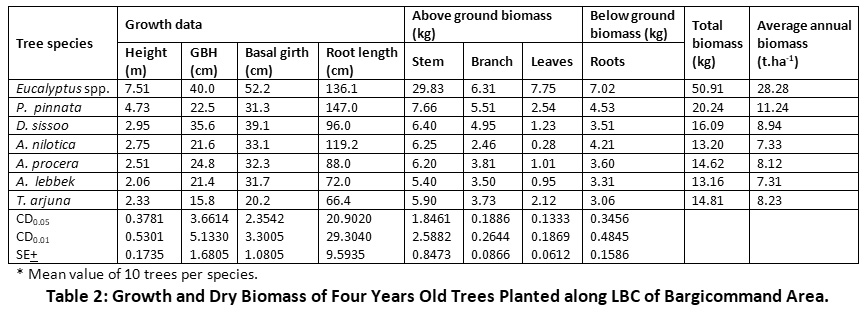 |
Table 2: Growth and Dry Biomass of Four Years Old Trees Planted along LBC of Bargicommand Area. Click here to view Table |
Similarly, maximum dry biomass per tree was recorded in E. hybrid (50.91kg), followed by P. pinnata (20.24kg) and D. sissoo (16.09kg) (Table 3). Minimum dry biomass per tree was observed for A. lebbek (13.16kg) and A. nilotica (13.20kg), but these species were found to have maximum root-shoot ratio (Fig. 3). The biomass of E. hybrid was recorded about 4 times compared to A. lebbek and A. nilotica, while the biomass of P. pinnata was recorded to be 1.5 times as compared to these species. Biomass allocation to leaves and branches was maximum in P. pinnata (39.77%), followed by T. arjuna (39.50%) and D. sissoo (38.4%), while it was found minimum in A. nilotica (20.76%). Biomass allocation to stem compared to total biomass was recorded maximum in E. hybrid (58.59%), followed by A. nilotica (47.35%).
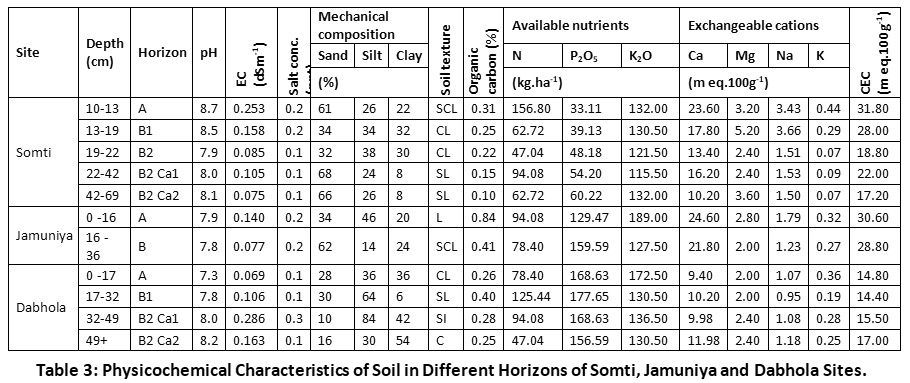 |
Table 3: Physicochemical Characteristics of Soil in Different Horizons of Somti, Jamuniya and Dabhola Sites. Click here to view Table |
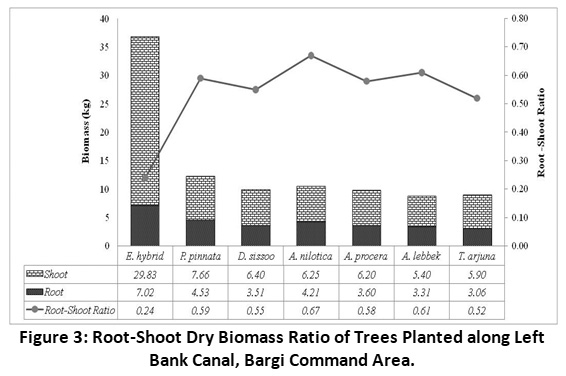 |
Figure 3: Root-Shoot Dry Biomass Ratio of Trees Planted along Left Bank Canal, Bargi Command Area. Click here to view Figure |
Annual biomass produced by four years old trees of different species considering 2m x 2m distance between trees and accommodating 2500 trees per hectare was quantified. Eucalyptus spp. accumulated 28.28t.ha-1 biomass annually, which was the maximum followed by P. pinnata(11.24t.ha-1),D. sissoo (8.94t.ha-1), T. arjuna (8.20t.ha-1),A. procera(8.12t.ha-1), A. nilotica(7.33t.ha-1) and A. lebbek (7.31t.ha-1). Above-ground biomass in high-density plantations of E.tereticornis, irrigated with secondary treated sewage water has been estimated to be 24.10t.ha-1, followed by A. excelsa (21.80t.ha-1) and Melia azedarach (12.60t.ha-1)25.
The soil profile of Somti varies from strongly alkaline to moderately alkaline, however in Jamunia site where soil depth is 36cm only, soil is mildly alkaline. But at Dabhola site, soil range from mildly alkaline to moderately alkaline with the depth of the soil. Electrical conductivity of the soil in the selected sites is comparatively low resulting low base saturation. Mechanical composition of the soil samples shows clear evidence of good infiltration and drainage condition. The most active fraction of the soil is clay and this is also present either on surface or in lower layer in all the study sites for higher quantity (8-54%). In Somti, the texture of the soil has been found as sandy clay loam to clay loam, which changes to sandy loam in the deeper layers of soil. Silt and clay percentage increases in the middle layer and this is very important for retaining moisture and survival of any tree species. Moreover, in Jamunia where soil depth is very shallow, loam to sandy clay loam textured soil is found. But at Dabhola site mechanical composition of the soil is little different, where texture of the soil on the surface and lower layers become heavier where as in the middle layer it shows loose texture.
Soil organic carbon is less because of the low crop density in the study sites26. However, it is comparatively higher in surface layer of Somti and Jamunia which further decreases down the depth. But in Dabhola site trend is little different and this may be due to the variation of soil texture of the existing profile. The concentration of available nitrogen is low in all three profile sites due to low crop density and less amount of litter present on the floor. Available phosphorous(P2O5) content is very high in all three studied profile sites because parent rock contains high amount of total phosphorous (Granite) (Table 3). The concentration of available potassium is in medium range (120-280kg.ha-1) in all the three studied profile sites. In Somti and Jamunia site exchangeable cations are comparatively higher in the surface layer, which gradually decreases down the profile. But at Dabhola site soil profile shows a drastic change in texture and due to this no definite sequence was noticed. The Cation Exchange Capacity (CEC) is positively correlated with the type and amount of clay minerals and organic carbon and also indicates nutrient status of the soil. However, in Somti, Jamunia and Dabhola sites the nutrient status of the soil exhibits medium range. The amount and range of CEC indicates that soil might have contained kaolinite, illite and muscovite type of mixed clay minerals present in all the soil profiles.
Higher growth characteristics and biomass accumulation in E. hybrid andP. pinnata and proportionately higher biomass allocation to leaves and branches attribute these tree species the most desirable for reclaiming waterlogged sites along canal command areas with similar edaphic and climatic conditions.
Conclusion
Tree plantations with comparatively deep rooting system consume more water than shorter vegetation by extracting water from several meters down the earth's surface. The trees having higher growth and transpiration rates can be used for reclaiming waterlogged sites through transforming their nutrient energy into wood biomass. In the present study, Eucalyptus hybrid and Pongamia pinnata plantations performed better than other tree species coinciding water consumption with the or growth and biomass accumulation. Hence, the plantations of these species can be raised along the canal with proper spacing between the trees and rows and required amendments to manage the ground water table through the process of biodrainage and to enhance the production of agricultural crops.
Conflict of Interest
The authors do not have any conflict of interest.
Funding Source
There is no funding or financial support for this research work.
Acknowledgments
The authors are thankful to Indian National Committee on Irrigation and Drainage (INCID), Ministry of Water Resources, New Delhi for providing financial assistance to conduct the study. The authors also thank the officers and engineers of Rani Avanti Bai Lodhi Sagar Pariyojana, Jabalpur and M.P. state forest department for providing 10 hectares of land for raising plantation of tree species along with LBC. The authors are grateful to the Director and Group Coordinator Research of Tropical Forest Research Institute, Jabalpur for imparting continuous guidance and support during the execution of the research project. Finally, thanks are also due to technical officers and staff of the Forest Ecology and Climate Change Division for raising plantation and analysing soil samples in the laboratory.
Obituary
It is with the profoundest regret that we must report the passing of Prof Shri Ramu Naik Orcid Id: 0000-0003-3650-9469. We express our most sincere condolences to his family, colleagues and friends.
References
- Annual Report 2018-19. New Delhi, India: Department of Agriculture, Cooperation and Farmers Welfare, Ministry of Agriculture and Farmers Welfare, Government of India;2019.220 pp.
- Pandey A. Environmental impacts of canal irrigation in India. Mediterr. J. Soc. Sci.2013; 4(11):138-143.
CrossRef - Goyal V.C, Jain S.K, Pareek N. Water logging and drainage assessment in Ravi-Tawi irrigation command (J&K) using remote sensing approach. J. Indian Soc. Remote. Sens. 2005;33(7):7-15. https://doi.org/10.1007/BF02989986.
CrossRef - Bowonder B, Ramana K.V, Rajagopal R. Waterlogging in irrigation projects. Sadhana. 1986;9(3):177-190.
CrossRef - Kumar P., Sharma P.K. Soil salinity and food security in India. Front. Sustain. Food Syst. 2020; 4:174. https://doi.org/10.3389/fsufs.2020.533781.
CrossRef - Heuperman F.A, Kapoor A.S, Denecke H.W. Biodrainage principles, experiences and applications, Knowledge synthesis report no. 6 Rome, Italy: International Programme for Technology and Research in Irrigation and Drainage, Food and Agriculture Organization of the United Nations. 2002. 79. http://www.fao.org/3/Y3796E/y3796e05.htm#bm05. Accessed on: 11/12/2020.
- Ram J, Dalal S.K, Meena K.C, Garg V. Biodrainage for salt-affected waterlogged soils. Paper presented at: Seminar on Biodrainage; 7 November 2002; Forest Department Haryana and Command Area Development Authority, Rohtak.
- Ram J, Garg V.K, Toky O.P, Minhas P.S, Tomar O.S, Dagar J.C, KamraS.K.Biodrainage potential of Eucalyptus tereticornis for reclamation of shallow water table areas in north-west India. Agrofor. Syst.2007;69:147-165.
CrossRef - Kapoor A.S. Biodrainage – A biological option for controlling waterlogging and salinity.New Delhi: Tata McGraw Hill; 2001. 315pp.
- Angrish R., Toky O.P, Datta K.S. Biological management of water: biodrainage. Curr. Sci.2006;90(7):897.
- Angrish R, TokyO.P, Patel R.K.Biodrainage: potential and practice. Hisar, India: CCS Haryana Agricultural University;2008.
- Jackson M.L. Soil chemical analysis. New Delhi, India:Prentice Hall of India Pvt. Ltd.; 1973.498 pp.
- Black C.A. Methods of soil analysis. Madison, Wisconsin, USA: American Society of Agronomy; 1965.1572 pp.
- Chopra S.L, Kanwar J.S. Analytical Chemistry. Ludhiana: Kalyani Publishers;1976. 514 pp.
- Piper C.S. Soil and plant analysis. Australia: University of Adelaide;1950. 368pp.
- Jain A., Mehta N. Carbon sequestration and crop productivity in eucalyptus-wheat agroforestry system. Int. J. Environ. Sci. 2020; 46(3-4):223-230.
- Jo Lawbuary, H.E.S. Eucalyptus planting in Social Forestry in India: Boon or Curse? Ganesha. http//:www/ganesha.co.uk/Articles/Eucalyptus.html. 2004. Accessed on: 19/01/2021.
- Shyam S.S, Parameswarappa S. Social forestry and Eucalyptus. Econ Polit Weekly.1989;24(1):51-52.
- Bhatt V, Purohit V.K, Negi V. Multipurpose tree species of western Himalaya with an agroforestry prospective for rural needs. J. Am. Sci. 2010; 6(1):73-80.
- Parrotta J.A, Roshetko J.M. Albizia procera- white siris for reforestation and agroforestry. World Agroforestry. https://www.worldagroforestry.org/publication/albizia-procera-white-siris-reforestation-and-agroforestry. 1997.Accessed on: 20/01/2021.
- Benthall A.P. The trees of Calcutta and its neighbourhood. Calcutta, India: Thacker Spink and Co;1933. 513 p.
- Bor N.L. 1953. Manual of Indian forest botany. Oxford University Press, London, UK. 441 pp.
- Ciesla W.M, Donaubauer E. Decline and dieback of trees and forests: A global overview.Food and Agriculture Organization of the United Nations Forestry Paper 0258-6150; 1994. 120;Rome.
- Biswas M, Biswas K, Karan T.K, Bhattacharya S, Ghosh A.K, HaldarP.K.Evaluation of analgesic and anti-inflammatory activities of Terminalia arjuna leaf.J. Phytol. 2011;3(1):33-38.
- TokyO.P, Vasudevan P, Black D.R, Harris P.J.C, Davies P.A.Biomass production in short rotation effluent-irrigated plantations in north-west India. J. Scient. and Ind. Res.. 2011;70(8):601-609.
- King A.E, Ali G.A, Gillespie A.W, Wagner-Riddle C. Soil organic matter as catalyst of crop resource capture. Fron.t Environ. Sci. 2020;8:50.
CrossRef






